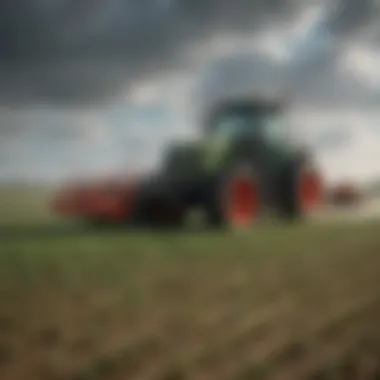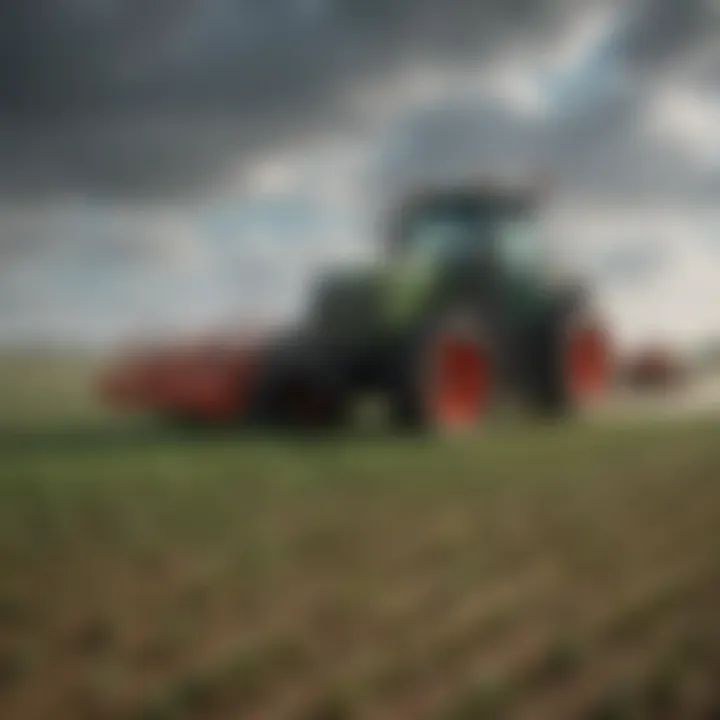Exploring Pre-Emergent Herbicides and Rainfall Effects


Overview of the Topic
Definition and Importance
Pre-emergent herbicides are a class of chemicals designed to inhibit the growth of weeds before they emerge from the soil. They work by targeting seeds, effectively preventing them from germinating. This is particularly crucial in agriculture, where weeds can compete with crops for nutrients, light, and water. The use of these herbicides can enhance crop yields and reduce the labor cost associated with manual weeding. However, their effectiveness can be significantly influenced by rainfall patterns. An understanding of how rain interacts with these chemicals is essential for achieving optimal agricultural practices.
Current Trends
Recent trends in agriculture show an increasing reliance on pre-emergent herbicides. With the pressures of climate change and variable weather patterns, farmers are turning toward these chemical solutions to maintain productivity. Innovations in herbicide formulations are also emerging, aiming for greater specificity to reduce environmental impact. Additionally, research is ongoing to understand the interaction between herbicide application and rainfall frequency, which is becoming critical as extreme weather events become more common.
Key Techniques and Practices
Step-by-Step Guide
To maximize the benefits of pre-emergent herbicides while accounting for rainfall, farmers can follow these steps:
- Soil Testing: Before application, conduct soil tests to determine moisture and nutrient levels.
- Choosing the Right Herbicide: Select herbicides tailored to your specific crop and weed types.
- Timing of Application: Apply herbicides before expected rainfall or when soil is sufficiently dry to prevent runoff.
- Follow Recommendations: Adhere to manufacturer guidelines for dosage and application methods.
- Monitor Weather Patterns: Stay informed about upcoming rain forecasts to adjust application times accordingly.
Tools and Equipment Needed
Farmers should equip themselves with the following tools:
- Sprayers: Proper sprayers are necessary for applying the herbicides evenly.
- Protective Gear: Ensure safety with gloves, goggles, and masks.
- Monitoring Equipment: Utilize soil moisture sensors and weather tracking devices to inform application decisions.
Challenges and Solutions
Common Obstacles
- Excess Rainfall: Heavy rainfall can wash away herbicides before they take effect.
- Soil Runoff: Chemicals can easily runoff into nearby water sources, raising environmental concerns.
- Resistance: Over-reliance can lead to weed resistance, making herbicides less effective over time.
Innovative Solutions
Farmers can consider these strategies to overcome challenges:
- Integrated Weed Management: Combine herbicide use with other methods such as crop rotation and cover cropping.
- Buffer Zones: Create buffer zones around water bodies to minimize runoff.
- Rain Alerts: Sign up for agricultural weather services to receive alerts about rain forecasts that can impact herbicide effectiveness.
Pre-emergent herbicides play a pivotal role in modern agriculture but require careful management in response to ever-changing weather conditions to ensure sustainability and effectiveness.
Understanding this relationship between pre-emergent herbicides and rain remains paramount for farmers looking to optimize their agricultural practices.
Preface
The intricate relationship between pre-emergent herbicides and rainfall patterns is crucial for modern agricultural practices. This article emphasizes the importance of understanding how these herbicides function, their optimal application methods, and the various environmental conditions affecting their efficacy. Farmers and agricultural enthusiasts face numerous challenges in preventing weed growth while maintaining crop health, which makes this topic timely and relevant.
The use of pre-emergent herbicides ensures that weeds do not compete with crops for essential resources. However, the performance of these herbicides relies heavily on rainfall. An effective application not only improves crop yields but also minimizes the risk of environmental consequences. To discuss this, we will examine the significance of pre-emergent herbicides, how they are influenced by weather patterns, and important considerations farmers should take into account.
Significance of Pre-Emergent Herbicides
Pre-emergent herbicides play an essential role in preventing weed germination and establishment. Their use allows for better crop management and can lead to higher production efficiency, particularly in high-density planting systems. These herbicides create a protective barrier in the soil, inhibiting weed seeds from germinating.
The advantages provided by pre-emergent use are numerous:
- Reduced weed competition leads to improved crop health.
- Farmers can allocate resources more effectively, lowering input costs.
- Enhanced crop productivity contributes to greater food security.
However, misuse or incorrect timing can lead to issues such as herbicide resistance or inadequate weed control. It is vital for farmers to understand both the benefits and challenges associated with pre-emergent herbicides, particularly how rainfall impacts their functionality.
Influence of Weather Patterns
Weather patterns significantly affect the performance of pre-emergent herbicides. The timing and amount of rainfall can determine how and when the herbicides activate in the soil.
It is important to note the following:
- Rainfall Timing: Successful herbicide activation typically requires appropriate moisture levels shortly after application. If rainfall occurs too early or too late, it can diminish effectiveness.
- Excess Rainfall: Heavy rain can lead to herbicide runoff, reducing the amount of product that reaches the target area. This can create gaps in weed control, resulting in crop yield losses.
- Insufficient Rainfall: A lack of rain may prevent the herbicides from activating properly in the soil, causing them to degrade more quickly and offering less protection against weeds.
Understanding these dynamics allows farmers to optimize their use of pre-emergent herbicides.


"Farmers must stay informed about weather patterns to maximize the effectiveness of their herbicide applications."
By tailoring their practices to local weather conditions, they can improve their weed management strategies and increase overall crop performance.
Understanding Pre-Emergent Herbicides
Understanding pre-emergent herbicides is critical to modern agricultural practices. These products prevent undesirable weed growth by targeting their development before they even emerge from the soil. Recognizing how these herbicides perform ensures farmers can employ them effectively, ultimately enhancing crop yield and minimizing competition for vital resources such as water and nutrients.
Each herbicide operates based on unique mechanisms that are influenced by environmental conditions. For effective implementation, farmers must also consider the timing of application alongside weather patterns. Notably, variations in rainfall can significantly affect the activation of these herbicides, which inevitably ties their use to broader agricultural outcomes.
Definition and Mechanism of Action
Pre-emergent herbicides serve to inhibit seed germination. They achieve this by creating a chemical barrier in the soil that disrupts critical processes within the germinating seeds.
Most pre-emergent herbicides are formulated with active ingredients that belong to specific chemical classes. Understanding these mechanisms helps in determining which herbicides to use in various conditions and for different crops.
Types of Pre-Emergent Herbicides
Chemical Categories
Chemical categories encapsulate the various types of pre-emergent herbicides, including groups like triazines and dinitroanilines. Each category has distinct advantages depending on the crops targeted and the specific weeds presenting challenges.
For example, triazines work by inhibiting photosynthesis in plants that ingest them. This makes them effective against broadleaf weeds but less effective on grasses. Dinitroanilines, on the other hand, disrupt cell division in seedlings. Each category thus plays a unique role in managing weed populations effectively while considering environmental safety.
Targeted Weeds
Targeted weeds refer to the specific unwanted plants that pre-emergent herbicides aim to control. Understanding which weeds a particular herbicide targets is crucial. For instance, a herbicide effective against crabgrass may not work on broadleaf weeds.
Recognizing these details aids farmers in making informed decisions about which herbicides to apply in their fields. Moreover, this information can prevent economic losses due to ineffective treatments and ensure the optimal growth of the desired crops.
Application Techniques
Timing of Application
Timing of application is one of the most critical aspects of using pre-emergent herbicides. Applying them at the right moment can determine their effectiveness drastically. It is most effective when applied before the target weeds germinate, which is often determined by soil temperature and moisture levels.
The key characteristic here is that incorrect timing can lead to poor results and increased weed pressure. Early application can cause herbicide degradation, while late application might miss the window for effective control.
Methods of Application
Methods of application can vary including broadcasting, banding, or spot treatment. Each method has its own nuances, affecting factors such as efficiency and environmental impact. Broadcasting spreads the herbicide across a wide area, which is useful for larger fields but may lead to waste or over-application in certain spots.
Banding involves applying the herbicide in narrow strips, which can enhance efficiency and reduce potential damage to non-target plants. Understanding these methods allows farmers to choose the most suitable application technique based on their specific field conditions and weed problems.
Effective herbicide management requires not only understanding herbicides themselves but also the environmental factors influencing their efficacy.
"Pre-emergent herbicides are critical tools in modern agriculture for controlling weed populations effectively, leading to better crop performance."
In summary, comprehending pre-emergent herbicides is vital for optimizing their use in agriculture. By acknowledging their definitions, mechanisms, types, and application techniques, farmers can enhance both the quality and quantity of their yields amid changing climatic conditions.
Impact of Rainfall on Herbicide Efficacy
The efficacy of pre-emergent herbicides is significantly influenced by rainfall. This impact is crucial for farmers and agricultural professionals who rely on these chemicals for weed control. Understanding how rainfall patterns affect herbicide activation, effectiveness, and longevity helps in making informed decisions about their usage.
Rainfall plays a dual role in herbicide effectiveness. On one hand, adequate rain is necessary for activating the herbicide in the soil. On the other hand, excessive rainfall can lead to unwanted outcomes, including runoff and leaching. In this context, rainfall is not just a weather phenomenon; it is an integral part of herbicide application strategy.
Additionally, the timing of rainfall can dictate the success of crop establishment and management of weed populations. These dynamics warrant thorough examination to optimize herbicide use under various conditions, maximizing benefits while mitigating risks associated with rainfall variability.
Rainfall Timing and Herbicide Activation
Rainfall timing is a key factor in activating pre-emergent herbicides. When applied to dry soil, these herbicides require moisture to penetrate the soil layer and become effective. Ideally, light to moderate rainfall within a specific time frame after application ensures that the herbicide interacts optimally with the soil.
If rainfall occurs soon after application, it enhances the herbicide's ability to control targeted weed species. However, if rainfall is delayed, the effectiveness may diminish, leaving crops vulnerable to weed encroachment. This highlights the need for farmers to monitor weather forecasts closely to time their applications effectively.
Effects of Excess Rainfall


Runoff Potential
Excess rainfall can generate runoff, a phenomenon where water flows over the soil surface instead of infiltrating it. The runoff potential is especially important because it may carry the herbicide away from the intended application area. This not only reduces the herbicide's effectiveness but also poses environmental risks by contaminating nearby water sources.
The key characteristic of runoff potential is its inherent unpredictability. Factors such as soil type, slope, and vegetation cover can influence how much herbicide is lost. While managing runoff may present challenges, employing buffer strips and contour farming can mitigate its impact.
Leaching of Herbicides
Leaching occurs when heavy rains wash herbicides deeper into the soil beyond the root zone of some weeds. This process can have negative implications for both crop safety and environmental health. The significant aspect of leaching is that it can lead to loss of herbicides from the target area, resulting in suboptimal weed management.
A unique feature of leaching is its dependency on soil characteristics and the chemical properties of the herbicide itself. Some herbicides are more prone to leaching than others, making them less suitable for areas with high precipitation. This creates a pressing need for farmers to choose their herbicide applications carefully, taking into account potential leaching risks.
Insufficient Rainfall Considerations
Chemical Breakdown Rates
Insufficient rainfall can lead to varied chemical breakdown rates of pre-emergent herbicides. Without moisture, the herbicides may not activate properly, rendering them ineffective against weeds. The breakdown rate can extend over time, affecting both short-term and long-term weed control.
The importance of understanding these rates cannot be understated. Farmers who apply herbicides during dry spells may find themselves facing uncontrolled weed populations later in the season. Therefore, keeping track of soil moisture levels becomes paramount to ensuring that applications are effective.
Implications for Crop Establishment
The implications for crop establishment under insufficient rainfall are significant. With ineffective herbicide activation due to lack of moisture, crops are more likely to struggle against weed competition. This can result in poor establishment, reduced yields, and overall economic losses.
The key characteristic of this situation is increased vulnerability of crops to weeds, which can complicate growth conditions. Farmers must thus consider both herbicide effectiveness and moisture availability when planning their planting strategies.
Best Practices for Using Pre-Emergent Herbicides
Using pre-emergent herbicides effectively requires an understanding of best practices that are rooted in soil science and weather patterns. These herbicides play a crucial role in weed management, especially in agriculture. When applied appropriately, they can deter weed growth without affecting crop establishment. Improper application, however, can lead to reduced efficacy and possible environmental concerns. Therefore, exploring these best practices is essential for agricultural professionals and enthusiasts.
Soil Preparation and Herbicide Interaction
Soil Moisture Levels
Soil moisture levels significantly affect how well pre-emergent herbicides perform. The right moisture is essential for proper activation of the herbicide. It helps in dissolving the chemical and allowing it to interact with weed seeds in the soil. A key characteristic of adequate moisture is its ability to enhance herbicide distribution within the soil profile, leading to more uniform effectiveness.
Maintaining optimal moisture levels is a beneficial choice for effective herbicide application. If the soil is too dry, herbicides may not activate properly, leading to incomplete weed control. Conversely, excessive moisture can cause runoff and leaching, reducing the active ingredient's availability in the root zone. By carefully monitoring soil moisture before and after application, farmers can ensure better performance of their herbicide treatments.
Physical Soil Conditions
Physical soil conditions, such as soil texture and structure, directly impact the interaction between the herbicide and the soil. Lighter soils, like sandy ones, tend to allow faster herbicide movement, while heavier clay soils may retain herbicides longer. The soil's physical characteristic affects how deeply the herbicide penetrates, which contributes to its effectiveness in controlling annual weeds.
This aspect makes understanding physical soil conditions a popular focus in best practices. Farmers should consider the unique features of their soil type and structure. For instance, compacted soils can hinder herbicide activation by restricting water infiltration. By conducting soil tests and managing compaction, practitioners can optimize the conditions for pre-emergent applications, balancing retention and mobility.
Monitoring Weather Forecasts
Weather plays a pivotal role in agricultural planning and is critical when using pre-emergent herbicides. Monitoring forecasts can inform farmers when to apply these products effectively. Rain predictions, temperature fluctuations, and humidity levels are essential factors to consider. Rain after application can enhance herbicide activation; however, too much rain or heavy storms can lead to runoff, impacting efficacy negatively. Therefore, staying updated with accurate weather forecasts can greatly augment herbicide application timing and ensure more effective weed control.
Adjusting Application Methods Based on Rain Predictions
Once aware of the weather forecasts, farmers should adjust their application methods accordingly. If substantial rainfall is expected, a delayed application might be preferable to avoid runoff. Additionally, adjusting the rate of application can become necessary based on expected rainfall amounts. For example, during dry periods, it might be prudent to increase the application rate when rain is expected soon, ensuring that enough herbicide reaches the soil surface for optimum weed control. By adapting their approach to the anticipated weather developments, farmers can enhance the effectiveness of their weed management strategies.
Environmental Considerations
The use of pre-emergent herbicides is crucial for managing weeds effectively in agriculture. However, it comes with several environmental implications that must be assessed. Understanding the impact of these herbicides on soil health and water resources is essential for sustainable agricultural systems. The examination of environmental considerations ensures that agricultural practices remain viable while minimizing negative effects on ecosystems.
Impact on Soil Health
Pre-emergent herbicides can influence soil health in various ways. These herbicides can disturb the natural microbial community essential for soil function. The application of these chemicals impacts nutrient cycling, which may lead to imbalances in soil fertility. It is important for farmers to recognize that a healthy soil ecosystem promotes robust crop growth.
Soil composition and its interaction with herbicides is another concern. Herbicides vary in their absorption rates depending on soil type and texture. For example, sandy soils often lead to higher leaching rates of herbicides, which can reduce their effectiveness while harming the soil structure. Therefore, understanding these dynamics is vital for maintaining soil health and optimizing herbicide application strategies.
Water Contamination Risks
Water quality is a pressing issue in agriculture, especially concerning the use of pre-emergent herbicides. The risk of chemical runoff into water sources can lead to significant ecological problems. The movement of these chemicals away from target areas not only contaminates water supplies but also affects aquatic life.


Runoff and Water Sources
Runoff occurs when rainfall exceeds the absorption capacity of the soil. In conditions where a heavy application of pre-emergent herbicides has been made, excess water can carry these chemicals into nearby streams and rivers. This can degrade water quality dramatically, impacting living organisms that depend on these habitats.
The key characteristic of runoff is its ability to transport herbicides away from intended areas of application. This can create wider environmental issues, affecting not just the immediate agricultural land but also the larger watershed. Effective management strategies are thus necessary to understand and mitigate these risks.
Strategies to Mitigate Risks
Mitigating the risk of water contamination from pre-emergent herbicides is essential for protecting water sources and maintaining ecological balance. Strategic planning around application techniques can significantly reduce runoff potential.
One approach includes utilizing buffer zones, which are areas of vegetation that help absorb runoff before it reaches water bodies. The unique feature of these strategies lies in their ability to filter out pollutants and stabilize soil, thereby reducing erosion.
Implementing integrated pest management practices can also serve as a beneficial methodology. By combining chemical controls with cultural practices, farmers can minimize reliance on herbicides, thus reducing the risk of contamination.
In summary, environmental considerations are critical when discussing pre-emergent herbicides. Recognizing their impact on soil health and the potential for water contamination will help farmers make informed decisions for effective and sustainable agricultural practices.
Research and Innovations in Herbicide Application
Research and innovations in herbicide application are crucial for enhancing agricultural productivity while mitigating environmental risks. The dynamic relationship between pre-emergent herbicides and rainfall makes it essential to explore new methodologies and technologies for application. Understanding these advancements helps farmers make more informed decisions about herbicide use, directly contributing to crop health and sustainability.
Emerging Technologies
Precision Agriculture
Precision agriculture epitomizes a modern approach to farming that integrates technology for better decision-making in crop management. One specific aspect of precision agriculture is the use of data analytics to optimize herbicide application. This technology allows farmers to observe field variability and apply herbicides more effectively, thereby reducing waste and enhancing efficacy.
A key characteristic of precision agriculture is its reliance on data-driven insights. This approach is beneficial because it allows for targeted herbicide application, minimizing the risk of non-target damage and environmental harm. The unique feature of this technology includes the use of GPS and sensors to monitor soil conditions and weed populations, providing farmers a clearer understanding of their field's needs.
However, there are some disadvantages. The implementation of precision agriculture requires upfront investment in technology and training. There can also be a learning curve as farmers adapt to new systems and understand data interpretations.
Drone Application Technologies
Drone application technologies represent another innovative tool in modern agriculture. This technology enables precise, aerial application of pre-emergent herbicides, significantly speedig up the process. Drones can efficiently cover large areas, ensuring uniform distribution of herbicides over difficult terrains.
The key characteristic of drone application is its ability to provide real-time data collection from the air, which enhances spatial analysis of agricultural fields. This technology is beneficial for its speed and flexibility, allowing timely responses to fluctuating weather conditions that can affect herbicide efficacy.
However, the unique feature of drone technology can also bring challenges. Issues like regulatory compliance or technical malfunctions may arise, potentially delaying application or leading to unintended consequences. Overall, while this method represents a substantial advancement, its use requires proper planning and execution.
Research Trends
Climate Impact Studies
Climate impact studies offer insights into how changing weather patterns affect herbicide performance. Evaluating the interactions between rainfall patterns and herbicide activity is vital for adapting agricultural practices. Such studies focus on understanding how variations in weather, like increased rainfall or drought, influence herbicide effectiveness and soil health.
A notable characteristic of climate impact studies is their emphasis on long-term data collection, which can highlight trends over time. They are an important choice for this article as they enhance our understanding of external factors affecting pre-emergent herbicides. The unique feature of these studies is their ability to inform farmers on when and how to adjust their practices in response to climate variability.
Advantages include the potential for improved crop yields and reduced chemical inputs, but there are also limitations. These studies often depend on historical data that may not fully predict future conditions, leading to uncertainty in decision-making.
Herbicide Resistance Mechanisms
Herbicide resistance mechanisms are critical to understanding how various plants adapt to chemical applications. This research area examines why some weeds survive pre-emergent herbicides, prompting the need for ongoing innovation in herbicide chemistry. One specific aspect of this research is identifying the genetic factors that confer resistance.
A key characteristic of this research is its dynamic nature, as it continuously evolves with changing agricultural practices and weed populations. It is beneficial because it provides insights that can lead to the development of more effective products, helping to combat resistance issues. The unique feature lies in the understanding of plant genetics, which can inform breeding programs aimed at creating resistant crops.
However, some drawbacks exist. Lack of awareness or education about resistance can lead to inconsistent application practices, exacerbating the problem. Ongoing education and research are crucial to address these challenges.
The development of innovative technologies and research trends in herbicide application is critical for achieving sustainable agriculture while managing environmental concerns effectively.
The End
The role of pre-emergent herbicides in agricultural practices is vital. Their significance extends beyond simple weed control; they also influence crop health and agricultural productivity. In this article, several aspects of this relationship have been detailed. This includes how rainfall affects the efficacy of these herbicides, the best practices for their application, and the environmental consequences they bring. Each consideration is essential to ensure that farmers and agricultural professionals make informed decisions in their practices.
Future Considerations for Agricultural Practices
Farmers must adapt to the changing climate and shifting weather patterns that directly impact agricultural practices. The application of pre-emergent herbicides should be carefully timed. The need for precise forecasting and monitoring to optimize herbicide effectiveness cannot be overstated. Soil conditions, moisture levels, and the timing of rainfall all play critical roles in determining the right moment to apply these chemicals.
Moreover, innovation in technology, such as the utilization of drones for herbicide application, is vital for efficiency. Farmers should also take into account the development of localized weather patterns. Continuous learning and management adjustments will help farmers navigate these complexities.
Key Takeaways
- Understanding Pre-Emergent Herbicides: Knowledge of chemical behavior and effectiveness in varied conditions is crucial.
- Impact of Rainfall: Both excess and insufficient rainfall can significantly alter herbicide performance. Timing and moisture play key roles.
- Environmental Considerations: Awareness of soil health and water contamination risks is essential for sustainable agriculture.
- Adapting to Change: Farmers must stay informed about weather patterns and invest in new technologies to enhance application efficiency.
As the agricultural landscape evolves, the commitment to best practices in the use of pre-emergent herbicides will be more important than ever. Through careful consideration and continuous adaptation, practitioners can optimize their strategies for successful crop management.



